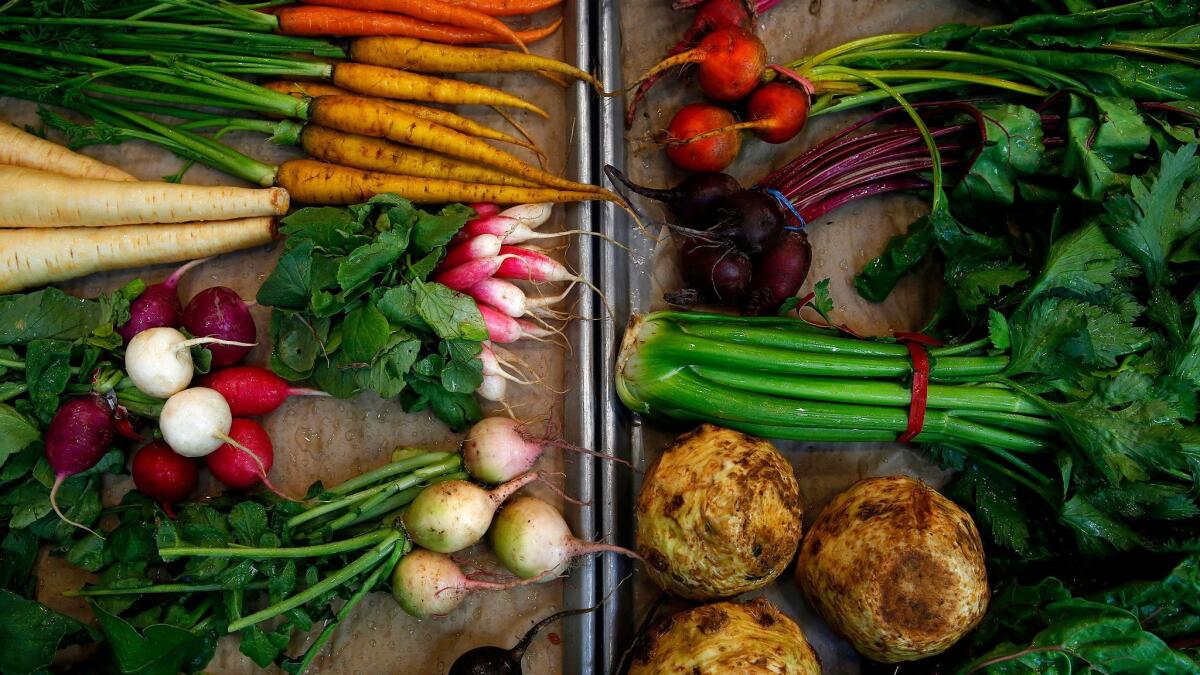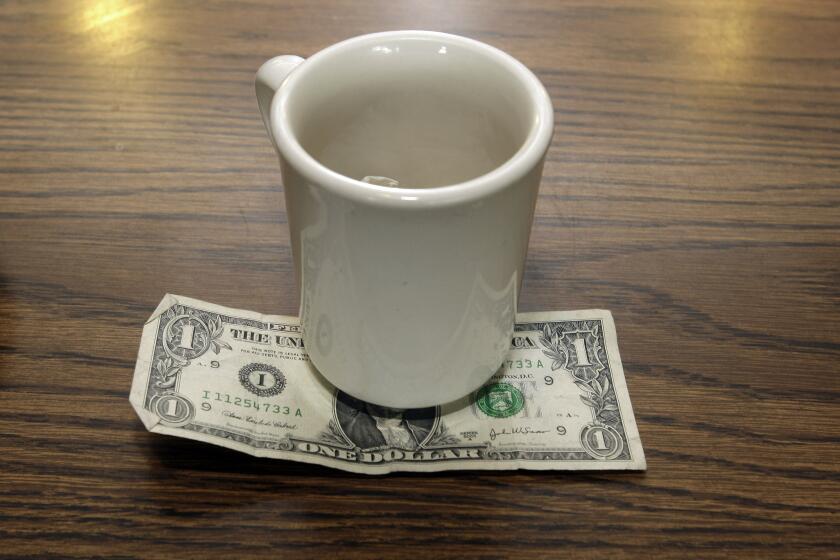A French chef makes a plate of vegetables into a work of art

Spring chef Tony Esnault uses seasonal vegetables from the farmer’s market to prepare his Legumes de Saison. Video by Liz O. Baylen
- Share via
We live in a time of outrageously beautiful food, when our Instagram feeds routinely show the latest garden on a plate from kitchens in Copenhagen or Mugaritz, when lunch at the corner restaurant can mean the chef’s market haul translated into a Caravaggio still life. Even so, the dish of seasonal vegetables that you’re presented at Spring, chef Tony Esnault’s French restaurant in downtown Los Angeles, will arrest your fork in mid-flight.
Esnault’s legumes de saison has been a staple at Spring since it opened last year, a plate of perfectly articulated vegetables that the chef calibrates to the season like his own personal Farmer’s Almanac. There is nothing overtly remarkable about it. It is a plate of vegetables, albeit more than a dozen of them. Each vegetable is cooked, or not cooked, separately and with great attention, and then the plate is assembled like a jigsaw puzzle. The conceit is hardly new: The garden on a plate traces a lineage through the kitchens of many chefs, including Michel Bras and Marc Veyrat and Alain Ducasse, with whom Esnault worked for many years and at whose New York restaurant Esnault first made the dish.
“The technique improves with experience, like a musician,” says Esnault, his voice registering his childhood in the Loire Valley, on a recent fall morning in Spring’s enormous open kitchen. It’s a light-filled, high-ceilinged space, filled with pale counter tops, state-of-the-art equipment, shelves loaded with Esnault’s collection of Mason jars and French pots, shiny pans hanging above the stoves like chandeliers. The chef and his crew have washed and dried the 16 vegetables that constitute the current version of legumes de saison and are now peeling radishes, trimming Swiss chard, fashioning yellow beets and purple carrots into a rainbow geometry. Each vegetable is then arranged on a giant sheet pan in a collage of colors, more Rauschenberg than Caravaggio.
“I love to prep,” says Esnault, surveying the counter and appraising a row of sunchokes lined up like an abacus. “It’s like meditation; this is my yoga.” A good thing, as this exercise is accomplished by either Esnault or one of his sous chefs every morning the restaurant is open. “These are also called topinambour,” he says of the sunchokes. “They used to give them to the pigs in France during the war. Now we’re cooking them in a fancy restaurant.”
Watching the chef cook the vegetables is like watching a man play a shell game. Esnault rotates sauté pans around the flat surface of the stove, moving lids from one pan to another to adjust the cooking inside, shifting the vegetables with a flick of his wrist. The methodology is actually very simple: Cook each vegetable according to itself. And watching this becomes a tutorial in technique. Depending on the size, texture and flavor, Esnault steams, braises, sautés, roasts, glazes or shaves the contents of the sheet pan, which have migrated into various bowls like an enormous mis en place.
“You want something crispy, something sweet, something caramelized, something fresh — not everything mushy,” Esnault says, adding cloves of garlic and sprigs of thyme to many of the pans. Nubs of butter, pours of olive oil. “You need to have diversity on the plate. It needs to be appealing visually. And in your mouth too.”
A pan of red cabbage is braised in a heady mixture of olive oil and garlic, fresh ginger and thyme and spoonfuls of stock that he’d made with the trimmings of the vegetables. Nothing is wasted here: Radish peels have been used to make their own stock, stained a bright red and infused with more thyme and garlic and verjus, the pressed and unfermented juice of unripe grapes that’s often used in Southern French cooking. Esnault strains the radish stock and adds it to the sautéing radishes, the contents of the pan turning the color of Santa Rosa plums. He moves many of the pans into the oven, some covered, some not, adjusting the seasoning, shifting the contents.

“I grew up on farms, at my grandparents’ farms in the Loire Valley,” Esnault, 45, says between sampling bites of celeriac and parsnips, kohlrabi and the chestnuts that he’s been sautéing in a short broth of browned butter, olive oil, stock, star anise and a small branch of dried fennel. “I used to pick the vegetables.” One pair of grandparents had a modern farm, the other still used horses. “Cooking is the same. You use both new and old techniques.”
As the vegetables reach their desired states, he tips them back onto the sheet pan until it’s again an enormous canvas of colors and shapes. A few vegetables remain raw: bright carrots and yellow beets, discs of watermelon radishes like cross-sectioned geodes. He makes a vinaigrette of reduced broth, vinegar and olive oil, and then sets out a shallow ceramic bowl. Watching him plate the dish is like watching a farmer set out a market stand: He arranges the vegetables, adding a pour of vinaigrette, some celery leaves and borage flowers, then finally a drizzle of French turnip seed oil.
“Fall is the most interesting,” Esnault says, rearranging a few caramelized chestnuts. “It’s more work, more challenging to cook rutabagas than English peas.”
As a sous chef deftly removes the last sauté pan from the stove, you realize that the sleight of hand in Esnault’s kitchen shell game is not in the resulting beautiful plate, but in the amount of work it takes to achieve it. Without a kitchen crew, without years of classical training and restaurant experience, this recipe (10 hours! a dozen and a half vegetables!) will take more than a little patience. So at home, maybe try a few vegetables, a little stock, white wine instead of verjus, your favorite California nut oil instead of French turnip seed oil, one or two pans. Contemplate the vegetables. Consider their properties. It’s your garden.
More to Read
Eat your way across L.A.
Get our weekly Tasting Notes newsletter for reviews, news and more.
You may occasionally receive promotional content from the Los Angeles Times.











